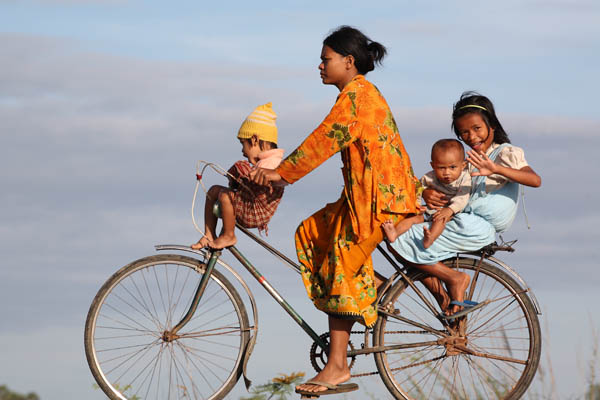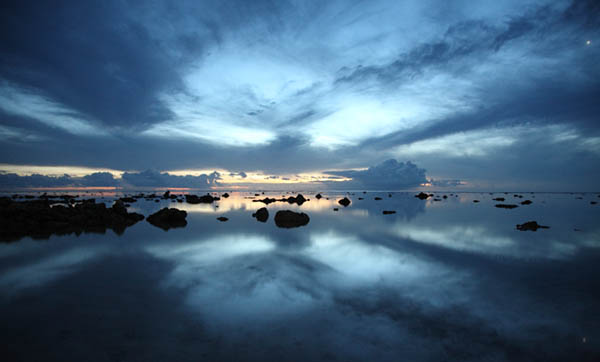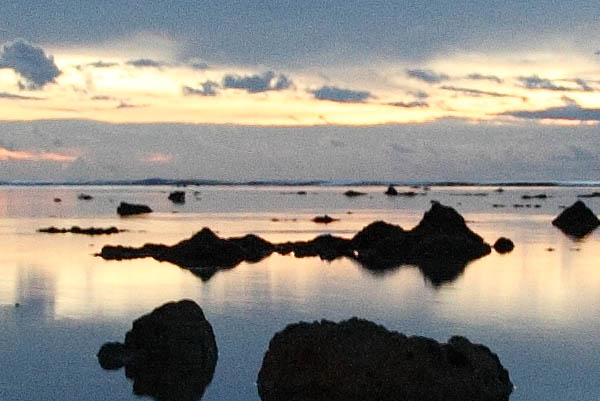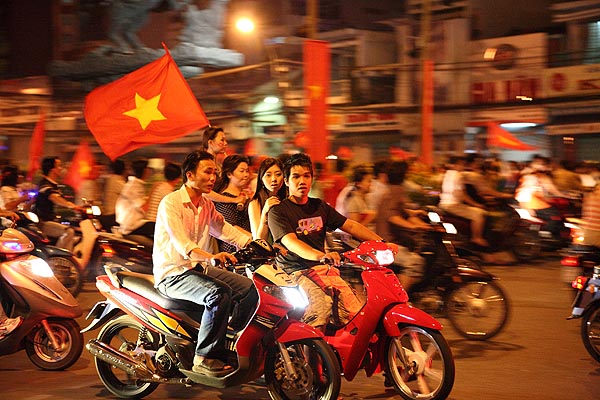EOS 5D
v
EOS 5D Mark II
PART 1 - Taking stock of the 5D mark I
|
“That’s ridiculous.” My wife’s comment on hearing that my new camera has 21 megapixels.
The truth is that, in the annoying way wives often do, she has a good point. We have a canvas print of the image above (taken with the old 5D) in our dining room. It is 130x90cm (51x35 inches) big, and it doesn’t lack resolution. If you press your nose against the canvas, you can see the canvas texture itself but the leaves still look sharp. So why do I need 21 megapixels? The reality is I probably need 21 megapixels about as much as a need a Ferrari. But if I could buy a Ferrari for £1800 I would get one of those too! The serious point is that there is very little wrong with the original 5D. But having taken the plunge and upgraded to the Mark II, I thought other 5D owners might like to know how the Mark II compares. When the 5D first came out, this website was the first to publish a detailed review, which I did by way of comparison to its predecessor in my camera bag, the 20D. As there were few other samples and image quality comparisons around at the time I indulged in pretty full-on pixel sniffing. I propose to do a similar comparison again, this time 5D vs 5D II. However this time others with more time and patience and possibly beadier eyes have compared the 5D II to its competition and squeezed the pixels of cats, walls and out-of-focus Christmas lights at 200% magnification until they've bled. So I'll try and focus differently (no pun intended). The real choice for most of us with an original 5D and investment in Canon lenses is not whether to "switch" to Nikon or Sony but simply whether to “upgrade” or stick with the more than adequate camera we’ve already got. I hope this article helps those who are making that decision. After over 3 years and 10,000 images, I’ve got one or two shots from the 5D which I’m pretty pleased with. But before I start looking at the 5D II, I think it would be worthwhile looking at some of the actual images I've made with the 5D and how better hardware could have improved them (if at all). I told you I was going to focus differently. Actual real-world photographic subjects - whatever next! Autofocus The reason not all cameras are the same is that we all have different shooting styles and needs. What a professional photographer at a football match does and what I do are two completely different things. The original 5D almost seemed like it was made especially for my needs - a jack of all trades which not only matched the best of the rest for high-resolution landscape photography but also beat them for low-light candids and street shots. With the 5D II, Canon have moved into a niche which fits exactly with my style of shooting, but others may now be better off with the competition, such as the Nikon D700 or Sony A900. The Nikon (allegedly - I have not used one) offers better autofocus for sports and wildlife photography and lower noise whilst the Sony (allegedly) has superior resolution for landscapes. I can no longer validly claim to have the "best" camera in humanity, as the competition has caught up!
For my use, whether other cameras have better autofocus is something of a moot point, as I cannot point to a single instance where the autofocus on the old 5D let me down. All I have is lots of perfectly in-focus shots like the example above, taken with the 200mm f2.8 prime lens at f8, which is about as sharp as things get. I have read a lot of complaints about the 5D's autofocus on internet forums, a large number of which were probably written by people who haven't ever been in the same room as a 5D never mind used one. At times I also forget that some people like to use the lottery-focus feature and let the camera choose which of the 9 weirdly-arranged autofocus points to focus on. I suspect like any lottery that can lead to disappointment. I almost always use the centre focus point and recompose if necessary (and if I have time).
Noise Paradoxically, I suspect that if the 5D's high ISO noise performance had been worse, a few of my images might have come out much improved. I say that because I am often tempted to rely on image stabilisation and high quality high ISO results rather than resort to the tedium of a tripod. This picture is a pretty extreme example, taken at ISO 1600, hand held (using the "dual image stabilisation" techniques of Canon's finest IS plus my knee) for 1.3 seconds at maximum aperture (f4 on the 24-105 f4 L). It is lightened slightly in processing which makes it noiser.
The bottom image is an "actual pixels" 100% crop (processed in DPP). It's pretty noisy as you might expect, but is pretty amazing, considering, and most importantly it is perfectly printable. 1.3 second exposure hand-held! Wide-open at f4! At 1600ISO! A few years ago when I was shooting Velvia 50 ISO in a Minolta Dynax film camera without image stablisisation, I would never have got away with this sort of laziness and would have been forced to get the tripod out and take a better quality photo. But that said, going back to film scans, even with a good scanner like my Minolta Dimage Scan Elite 5400 and top film like Velvia 50 ISO, grain rarely looks much better to me than that in the sample above. It's pretty amazing how far things have come. Sometimes, however, tripods don't help and only fast film speeds will do. I've had some good results from the 5D in those situations. Of course better high ISO performance is always welcome, but the 5D is an excellent compromise between good high ISO performance and high resolution. I would not want to trade high ISO performance for more resolution.
The image above was shot on the 5D at 3200ISO, hand-held at 1/20th second, wide open again (f4) at 70mm. 3200ISO was therefore needed. 1600ISO would not have done (the shutter speed would have been too slow as it was already seriously pushing the limits) so it is a valid real-world high ISO noise example.
Above are two 100% crops from that image. The top one is the JPEG straight out of the camera. It is perfectly decent. The bottom one is from the RAW file (I always shoot RAW + JPEG) processed in DPP with no luminance noise reduction and chrominance NR of 50%. I think it illustrates that you should always shoot RAW at high ISO as to my eyes the bottom crop has much more detail and the noise has a more acceptable "film-like" look. Look at the detail in the girl's hair, and the crunchy film-like graininess of the out-of-focus background compared to the colour-blotchy digital-looking smeariness of the JPEG above it. Of course the difference would only be visible, if ever, in a very large print. Frame rate When I first got my old EOS 20D, I went a bit mad with the awesome 5 fps frame rate and machine gunned everything that moved. No decent images resulted. The Cambodian and Vietnamese bike photos above were the result of single, well timed exposures. Both were the only images I took of those particular subjects. My shooting style has evolved to avoid continuous shooting, so higher frame rate is quite an irrelevance to me and not on my wish list for 5D upgrades. Other people, of course, have different priorities. Resolution Everybody wants more resolution. Why? Because there are two things you can do with it - more cropping and making bigger prints. For some reason the prints I've wanted to make big have not needed any cropping whatsoever. The Cambodian family on their bicycle and the Thai waterfall images above are straight out of the camera with no cropping. Interestingly the manual for the 5D Mark II suggests that full 21 megapixel mode on the Mark II can be used for "A2 or larger" prints, whilst 9.9 megapixel SRAW1 mode is good for "around A3" and 5.2 megapixel SRAW2 mode "around A4." I have an A2 print of the 12.8 megapixel 5D image below in my office, which looks stunningly sharp to me. Others have commented similarly. At that size, despite the relatively small aperture of f8, the depth of field is very noticeable. The daisies in the foreground are not as sharp as those in the plane of focus, in the centre of the image where the tallest burnt tree is.
The canvas print of the Thai waterfall I mentioned at the top of this article is 130x90cm - that's bigger than A0, more than four times the size of A2! So lack of resolution hasn't stopped me making great prints as big as I've ever wanted. Nevertheless, more resolution is "nice to have", so would make it onto my wishlist of upgrades. Operation and handling It seems to be fashionable on internet forums to mention the "clunky" handling of the 5D, and Nikon's superiority in that respect. I can't comment on the comparison as I've never used a Nikon DSLR in anger. But I can confirm that the 5D handling is, indeed, pretty "clunky." The handling is basically exactly the same as the old 20D but with the added annoyance of lots of useless 1/3 stop increments for ISO adjustment. A common complaint is that the mirror lock-up facility is fiddly. I couldn't care less as I've never used that feature (I suspect Canon buried it in a menu on purpose after their evaluation confirmed that it makes no difference - I will have to do my own test some day). Another complaint I've seen repeated a few times is that writing to the CF card stops abruptly when the card door is opened (to avoid corrupting data if the card is removed during writing). That seems wholly sensible to me. My top 10 operational and handling annoyances for the 5D are: 1) No USB charging. If my blackberry can do it, why not the camera? This would be an awesome feature, as at the moment if you lose the battery charger, it breaks or you leave it at home, your photography is over once your batteries are used up. High streets in Easter Island don't sell these things! With USB charging you could top up the battery in the car using a Blackberry charger between locations. 2) No auto-ISO. This is a real pain, as it forces you to think about ISO for each shot and usually fiddle around changing it, which is made worse by the next point... 3) ISO adjustment is not intuitive. You would think after over 10,000 shots, often changing ISO every 3 or 4 shots, my hands would just go straight to the relevant control automatically. Nope. It's so badly designed, 50% of the time I adjust the drive mode instead, usually to self-timer, then have to change that back and start again trying to remember how to change the ISO. When I do get the right dial I always want a full stop of adjustment, but have to move the wheel 3 clicks to achieve that because it advances in pointless 1/3 stop increments. Awful. 4) No 2-second self timer. Having to wait 10 seconds each time when taking night-shots and I've forgotten the cable release is a pain. 5) Dust. It's not a major problem but it is an annoyance. 6) No SD card slot. I actually bought a CF to SD adapter so I can use SD cards in the 5D (very handy as I can use the same cards as my little Canon Ixus 850, and they can then slip straight into the laptop to be read without needing a card reader or adapter). 7) LCD "flashing highlights" show burnt-out areas on the JPEG, not the RAW data. It took me ages to realise that blown-out areas which flash on the LCD review can often actually be recovered from RAW files and I was misinterpreting that and underexposing unnecessarily to avoid blowing-out highlights in JPEGs. 8) The camera broke. Twice. First time it froze up and would not shoot again until I replaced the memory card. All the pictures on the "corrupted" memory card were lost. I don't know what caused it, but I've never had any problems with that card again. I suspect it was the "auto-rotate" bug which was mentioned in the firmware update literature, because I worked around it by turning off the auto-rotate feature and the problem never recurred. Fortunately I didn't attempt to update the firmware whilst in Vietnam because when I got home and updated the firmware, it killed the camera! This time nothing would persuade it to come back to life and it had to go back to Canon, who replaced the "motherboard." I never did realy get a straight story out of them but Canon's UK agent suggested that this was a "common" problem with early 5Ds! Whilst I'm on this subject, my original 24-105L got replaced under warranty too, as it had the "flare" issue which was the equivalent of the current "black dots" hysteria. Out of thousands taken with that lens, I had about 2 (which were rubbish anyway) which featured the flare. 9) No weather sealing. Didn't stop me using it in the spray at the Iguassu falls. Camera and lens got pretty saturated, but didn't break. Weathersealing would not, therefore, have made any difference to the result but it would have reduced my stress-levels! 10) LCD is rubbish, particularly the colour. It is quite disheartening to see photos which you have high expectations for on that manky little LCD. You can only tell what the colours came out like once the images have been transferred to a computer. It is rumoured that later model 5Ds have a better LCD than my early one. 11) Autofocus points are bizarrely arranged in a funny shape and too close to the centre of the frame. The 20D was better. My subjects are never located at any of those points, so I simply don't use them. I know I said it would be 10 annoyances but I couldn't let this one go without comment! |








